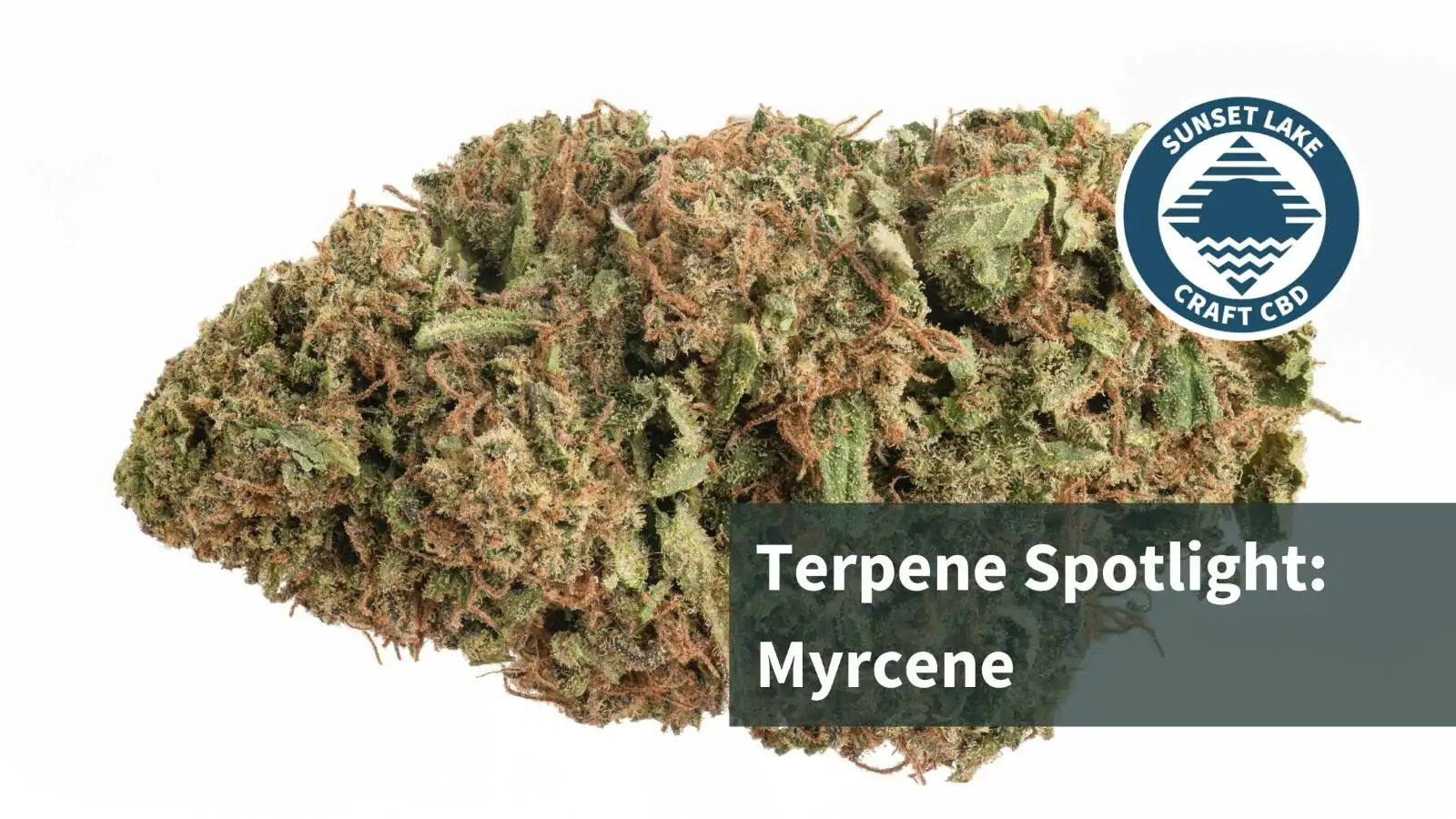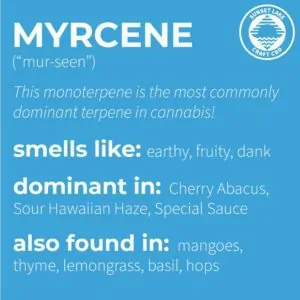As public attention and research continue to explore all the potential benefits of hemp, many consumers are increasingly interested in cannabis’s active components beyond just CBD and THC. Terpenes feature prominently in the discussion about how hemp smells and how it makes you feel. There are dozens of terpenes found in hemp flowers, and the most common terpene in hemp is Myrcene (“mur-seen“).
What We’ll Cover
In this post, we’ll discuss:
- What Myrcene is
- Where you can find it in nature
- What its potential benefits may be
What Are Terpenes?
Before we dive into Myrcene, let’s review what terpenes are. Terpenes are organic molecules responsible for the aroma of fruits, flowers, and some animals. You’ve likely encountered many in your own home without even knowing. For example, do you know that clean, acidic smell you get when you peel an orange or lemon? That’s due to a terpene called limonene, which you can find in all citrus fruits.
Examples of Terpenes
- Pinene: Responsible for the fresh scent of pine trees (and Pinesol).
- Linalool: Found in lavender flowers, known for its calming nature.
- Ocimene: Gives basil its delicious, herb-y aroma.
Technically speaking, terpenes are volatile hydrocarbons, meaning they like to turn into gas and diffuse into the surrounding atmosphere. That’s why it’s easier to associate terpenes with their smell than anything else.
Read more: What Are Terpenes? Terpenes 101
What Is Myrcene?
Myrcene is a monoterpene made up of two isoprene units, which are the basic building blocks of all terpenes. Isoprene units consist of five carbon atoms and eight hydrogen atoms. Alone, they’re a bit boring, but they shine when configured into groups of two, three, four, and so on.
Myrcene, as we mentioned, is made of two isoprene units, so it is relatively basic. But that doesn’t mean that this terpene doesn’t pack a punch. You can find Myrcene in mangoes, thyme, lemongrass, cardamom, hops, and hemp. Its aroma is complex and musky but fruity with notes of hops, tropical fruits, and woody spices.
In hemp and cannabis plants, Myrcene is both the most commonly found terpene and the most common dominant terpene, meaning that we usually see it as the top terpene in any one cultivar.
Natural Sources of Myrcene
Myrcene is not limited to hemp and cannabis. It’s found in a variety of plants and herbs. For instance:
- Mangoes: The presence of Myrcene is what gives mangoes their distinctive musky aroma. Some enthusiasts even suggest eating a mango before consuming cannabis to enhance the effects, though scientific evidence on this is anecdotal.
- Thyme: This herb is another rich source of Myrcene. It’s widely used in cooking and traditional medicine for its aromatic and health properties.
- Lemongrass: Popular in teas and culinary dishes, lemongrass contains high levels of Myrcene and is valued for its calming effects.
- Cardamom: This spice, often used in cooking and herbal medicine, also boasts Myrcene as one of its components.
- Hops: Known primarily for their use in beer brewing, hops contain significant amounts of Myrcene, contributing to the aroma and flavor profile of various beers.
The Aroma Profile of Myrcene
The scent of Myrcene is quite distinctive. It’s often described as earthy, musky, and herbal with a hint of fruitiness. This complex aroma profile makes Myrcene a key player in the overall fragrance of many plants and essential oils. The combination of these scents can have a significant impact on the perception of cannabis and hemp products, influencing user preference and experience.
Health Benefits and Uses of Myrcene
Many folk medicine traditions embrace Myrcene for its calming and relaxing effects. In Germany, they use hops, high in both Myrcene and Humulene, as a sleep aid. Similarly, in Mexico, they use lemongrass tea, which is high in Myrcene, for its sedative properties.
Potential Health Benefits
- Anti-inflammatory Properties: Myrcene has shown potential in reducing inflammation, which can be beneficial for conditions like arthritis and other inflammatory diseases.
- Muscle Relaxant: Research suggests that Myrcene can act as a muscle relaxant, providing relief from cramps and spasms.
- Pain Relief / Analgesic Properties: Myrcene may have analgesic properties, making it useful for pain management.
- Sleep Aid: Its sedative effects could make Myrcene a natural aid for improving sleep quality.
- Anti-anxiety: Myrcene might help reduce anxiety, providing a natural way to manage stress.
- Antioxidant Properties: Myrcene exhibits antioxidant properties, which can help protect cells from damage caused by free radicals.
Myrcene and the Entourage Effect
When someone uses Myrcene in combination with CBD and THC, it’s thought to contribute to the “couch lock” effect, adding to the notion that Myrcene may have sedative effects. This interaction is part of what is known as the “entourage effect,” where different cannabis compounds work together to enhance the overall effects of the plant.
Ongoing Research
Research into the potential health benefits of Myrcene is ongoing. Scientists are investigating its efficacy in various applications, including its use as an anti-inflammatory agent, muscle relaxant, and pain reliever. Preliminary results are promising, but more studies are needed to confirm these benefits and understand the mechanisms involved.
Sunset Lake CBD Cultivars Featuring Myrcene
Sunset Lake CBD’s hemp flower cultivars naturally contain many terpenes. Cannabis researchers believe that sun-grown hemp and cannabis produce more terpenes than indoor hemp flowers.
We send all our cultivars’ samples to third-party laboratories for terpene testing. Here are our top cultivars and their Myrcene content:
- Cherry Abacus: 1.24%
- Sour Hawaiian Haze: 1.01%
- Hawaiian Haze: 1.14%
- Special Sauce: 0.94%
- Lifter: 0.87%
- Sour Suver Haze: 0.80%
- Suver Haze: 0.57%
Note: the percentage of terpenes is reported on a by-weight basis.
Comparing Myrcene Levels in Competitor Products
To give you a clearer picture, let’s compare the Myrcene levels in Sunset Lake CBD’s products with those from other leading brands in the market. This comparison helps highlight the quality and potency of our products.
Competitor A:
- Strain X: 0.75%
- Strain Y: 0.89%
- Strain Z: 0.92%
Competitor B:
- Strain M: 0.68%
- Strain N: 0.77%
- Strain O: 0.83%
As seen, Sunset Lake CBD’s cultivars generally have higher Myrcene content compared to these competitors, ensuring a richer terpene profile and potentially more pronounced effects for users.
Understanding Terpene Testing
Terpene testing is a crucial part of ensuring product quality and consistency. At Sunset Lake CBD, we prioritize transparency and accuracy by using third-party labs for our testing. These tests not only confirm the presence of Myrcene and other terpenes but also measure their concentrations, ensuring that our products meet the highest standards.
The Importance of Terpenes in CBD Products
Terpenes play a significant role in the effectiveness of CBD products. They contribute to the overall therapeutic profile and can influence the experience of the user. By understanding the terpene content, consumers can make more informed choices about which products may be best suited to their needs. Visit our Website Sunset Lake CBD.
FAQs
- What is Myrcene?
Myrcene is a common terpene found in hemp, known for its musky, fruity aroma and potential relaxing effects.
- What are the benefits of Myrcene?
Myrcene is believed to have calming, anti-inflammatory, pain-relieving, and antioxidant properties.
- Which Sunset Lake CBD products contain the most Myrcene?
Cherry Abacus, Sour Hawaiian Haze, and Hawaiian Haze are among the top Sunset Lake CBD cultivars with high Myrcene content.
- How does Myrcene affect the “couch lock” effect?
When combined with CBD and THC, Myrcene is thought to contribute to the “couch lock” effect, enhancing sedative properties.
- Where else can you find Myrcene in nature?
Myrcene is found in mangoes, thyme, lemongrass, cardamom, hops, and various hemp and cannabis plants.


